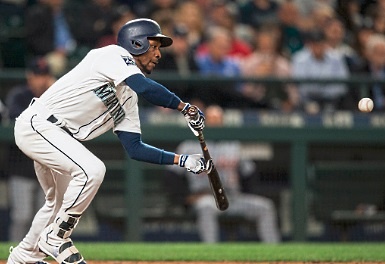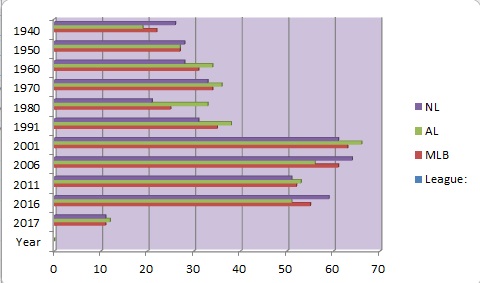Every sports league has them…the rules that aren’t in the league’s official rulebook. The so called, “unwritten rules”. Baseball is full of them, many of which are antiquated. It’s time the unwritten rules got rewritten, or whatever you do to modify things that are unwritten.
Bunting to Breakup a No-No
Last week, the Detroit Tigers’ Justin Verlander took a perfect game into the 6th inning against Seattle. The Mariners’ speedy outfielder, Jarrod Dyson, laid down a perfect bunt to end Verlander’s perfection and his no-no all at once.
The Tigers held a 4-0 lead at the time that Dyson reached. By getting on base, Dyson sparked a rally in which the Mariners cut the lead to 4-3. One inning later, Seattle took the lead and won the ballgame (if I were in attendance I would have given Dyson a standing ovation).
For years it has been taboo to bunt when the opposing pitcher has not allowed a baserunner to reach safely. Somehow, the bottom line imperative of winning has been forgotten. Those who still feel a bunt in this situation is baseball blasphemy are stuck in the stone age.
Back in 2001, the Diamondbacks’ Curt Schilling had a perfect game going into the 8th inning against San Diego. Down 2-0, Padres’ catcher Ben Davis bunted his way on to break up Schilling’s attempt at perfection. The Diamondbacks won 3-1, but Diamondbacks manager Bob Brenly called Davis “chicken” for bunting.
To review, the Padres were down two runs late in the game and hadn’t had a baserunner. The Padres needed to do whatever they could to get on base, and that’s exactly what Davis did. At the time, Brenly conceded that he was”old school”, which he said didn’t mean he was right, but he didn’t think Davis was right either.
Diamondbacks’ first baseman Mark Grace didn’t have a real problem with the bunt since it was a close game, but added he “…wouldn’t have had the guts to bunt in that situation”.
Brenly felt his opposing manager, Bruce Bochy, would agree with him. But, Bochy didn’t and defended Davis’ action. The goal is to win games no matter how it is (legally) accomplished. Somehow that basic principle has been cast aside when a pitcher has a no-hitter in progress.
The Beanball War to End All Wars
“He sends one of yours to the hospital, you send one of his to the morgue.” – Jim Malone to Elliot Ness, The Untouchables (1987).
The brushback, the beanball, and the hit batter battles that have taken place in baseball over the years have completely gotten out of hand in the game today. There seems to be no concern over the injury a pitcher can inflict with an upper-90-mph fastball. And, the reasons for hitting or knocking down batters are, at times, ridiculous.
You will hear a retired player-turned-broadcaster drone on about the good old days. The days before the designated hitter (DH) existed and when a pitcher got a taste of his own medicine for aggressively throwing at a hitter. But, there were plenty of ugly brawls in the Major Leagues long before the American League adopted the DH rule. And there are still ugly battles taking place in the non-DH National League.
Prior to his retirement, the Tony LaRussa-led St. Louis Cardinals had a nasty back and forth with the Cincinnati Reds. LaRussa didn’t believe in the “eye for an eye” biblical philosophy but instead agreed more with the philosophy of fictional g-man Jim Malone…no “an eye for an eye:”, but “two eyes for an eye”.
We saw how things can escalate this season when the Baltimore Orioles and Boston Red Sox partook in the theater of the absurd. It began when the Orioles’ Manny Machado took a hard, borderline late slide into Red Sox Dustin Pedroia in an attempt to break up a double play.
The second baseman was spiked on the play and came up limping. Machado tried to catch Pedroia as he was about to fall and has not wavered from his statement that he did not intend to injure Pedroia (see below). The Red Sox didn’t buy Machado’s response and didn’t like the way Machado picked up his right foot in what they felt was a deliberate attempt to wipe out Pedroia, who was forced to leave the game. Whether or not it was discussed internally, the Red Sox immediately painted a bullseye on Machado’s back.
“It wasn’t intentional. I was trying to get on the bag,” Machado said. “You can see the replay to see how I come off the bag and hits (sic) him in the calf. I’m not going to change the way I play. I’m going to keep playing hard and do what I have to do to help my team win. It wasn’t intentional.” – Boston Globe
Matt Barnes throws at Manny Machado for spiking Pedroia on Friday pic.twitter.com/X70Fb3KvgD
— Boston Sports Info (@bostonsportsinf) April 23, 2017
Barnes got a four-game suspension. Had he hit Machado, it likely would have been eight to 10 games (there’s an inequity with suspensions as well; the punishment is generally far shorter than the amount of time an injured beanball victim is out of action).
That should have been the end of it, but it wasn’t. The two teams met again in Boston the following week. In the series opener, Orioles’ starter Dylan Bundy hit the Red Sox’ third-place hitter, Mookie Betts, in the hip. The next night, Boston’s Chris Sale once again threw behind Machado. Since Machado also hits third in the order, speculation was that Sale retaliated for Betts.
Chris Sale, “inside” 98mph Fastball to Machado. pic.twitter.com/zcDEWdlcuj
— Rob Friedman (@PitchingNinja) May 2, 2017
Though Sale’s pitch was below the waist, it still was behind the hitter. To make matters worse, home plate umpire D.J. Reyburn gave both teams a warning instead of immediately ejecting Sale from the game. The intent was clear, but Reyburn didn’t have the nerve to toss one of the best pitchers in baseball in his home park.
With umpire Sam Holbrook behind the plate in the third game of the series on Wednesday, Orioles’ starter Kevin Gausman was ejected when a 76.6 mph curveball hit Red Sox shortstop Xander Bogaerts.
Needless to say, Orioles’ manager Buck Showalter had a fit – and rightly so. Unfortunately, this will likely not be the end of the Orioles and Red Sox issues this season.
This is not the armed services. These unwritten codes for when retaliation (or instigation) should take place are ridiculous. It’s particularly dangerous in the 21st century with an abundance of pitchers who throw 95-mph and up, but do not have pinpoint control.
HBP average per year
Empower the Umpires
One way to curtail beanball fiascos is to allow umpires to give a quicker boot to an offending pitcher. If a batter gets hit or gets thrown at after the previous batter hit a home run, eject the pitcher. If the batter gets hit or thrown at after homering his last time up, eject the pitcher.
Sure, there will be times when a pitcher gets ejected for throwing a 70-mph breaking pitch. But it would help to stop, or at least curtail, the intimidation, retribution and utter nonsense that takes place between teams like Baltimore and Boston.
I Saw the Sign
The art of stealing signs is older than the game itself, and more prevalent than you think. “The shot heard round the world”, aka the Giants’ Bobby Thompson‘s 1951 pennant-winning home run vs. the Dodgers, became tainted years later when it turned out the Giants were stealing signs all season long. Thompson claimed to have not known what pitch was coming from the Dodgers’ Ralph Branca, but it’s hard to believe that’s true, knowing what we now know.
On the other hand, does it really matter if teams are figuring out the other teams’ signs? During the 2016 playoffs, the Dodgers were convinced the Cubs’ Ben Zobrist was stealing signs. Yasmani Grandal called them out on it.
“Did we know [Ben Zobrist] had the signs and was doing something for it? Yeah, we did …”
[…]
“We are literally paranoid when it comes to men on second and they are trying to get signs.”
Zobrist denied it:
This is hilarious….umm…no I was not stealing signs. Glad you think my baseball IQ is that high. https://t.co/2XMFmQJS5i
— Ben Zobrist (@benzobrist18) October 18, 2016
Grandal can say all he wants, but I have no doubt that the Dodgers and every other team tries to steal signs too. It’s just not talked about or flaunted. No one complains when the opposing pitcher is tipping his pitches. Is that not a form of sign stealing – especially since it’s not necessarily the batter that figures out what pitching is coming?
As long as the sign stealing takes place on the field or in the dugouts, it’s no big deal. On the other hand, if a team has someone stationed in a blimp with a telescope…
Stop, Thief!
Another way to get thrown at is by violating the unwritten rule about stealing bases when your team is up by a seemingly comfortable margin. But, in today’s game is any lead truly safe? This is especially true in some of the current hitter-friendly ballparks.
If you watch the Yankees television broadcast on a regular basis, you may have heard Michael Kay tell the story of when the Tigers’ Sparky Anderson was infuriated at the Yankees’ baserunning tactics. Up 6-0, the Yankees stole a base against the Tigers and Anderson went ballistic. But, Detroit came back and won the game.
While the Yankees extended their lead Wednesday night against the White Sox, newest Yankees rookie Miguel Andujar stole second base with his team up six in the 8th inning. I had no problem with it, especially after the Yankees bullpen had blown the lead the night before.
Unless your team is up 18-0, there’s no reason not to steal or to take an extra base on a teammate’s base hit. With so many great hitters in the game today and so many relievers that look overmatched, a 9-0 lead can turn into 9-5 real quick. Earlier this season, the Yankees came back from a 9-1 deficit to the Orioles and won 14-11 in 10 innings.
A New Unwritten Rule
This is the exception. An unwritten ban on ex-players saying “in my day”.
It’s a different game today. Get over it.





